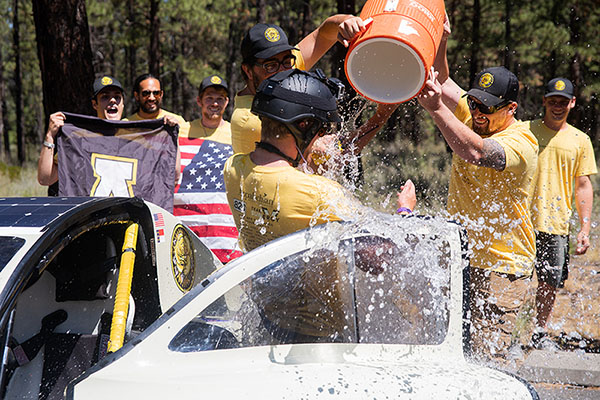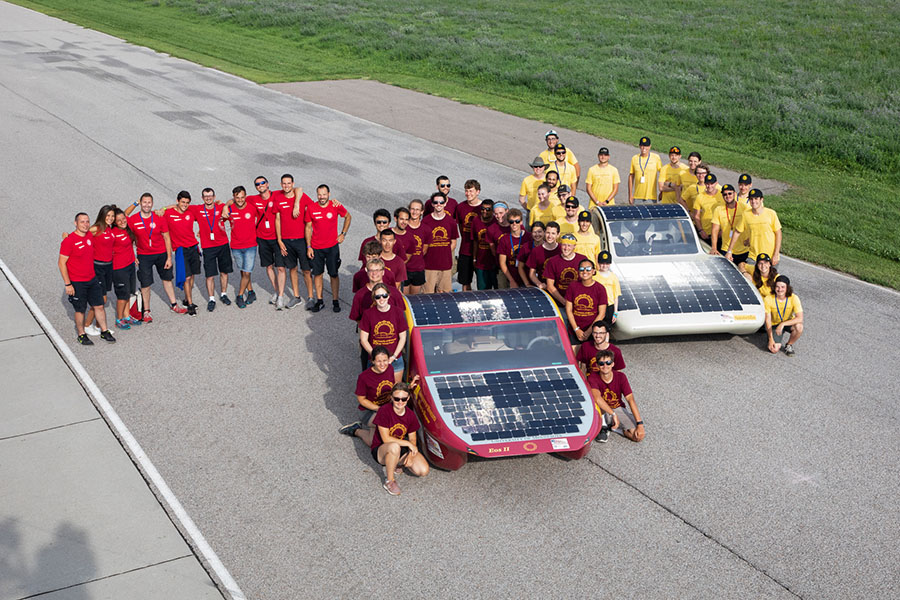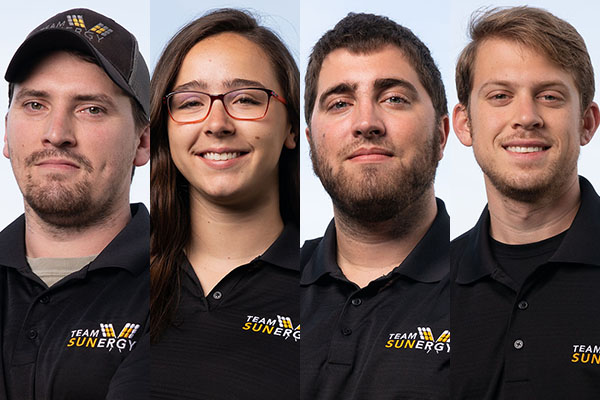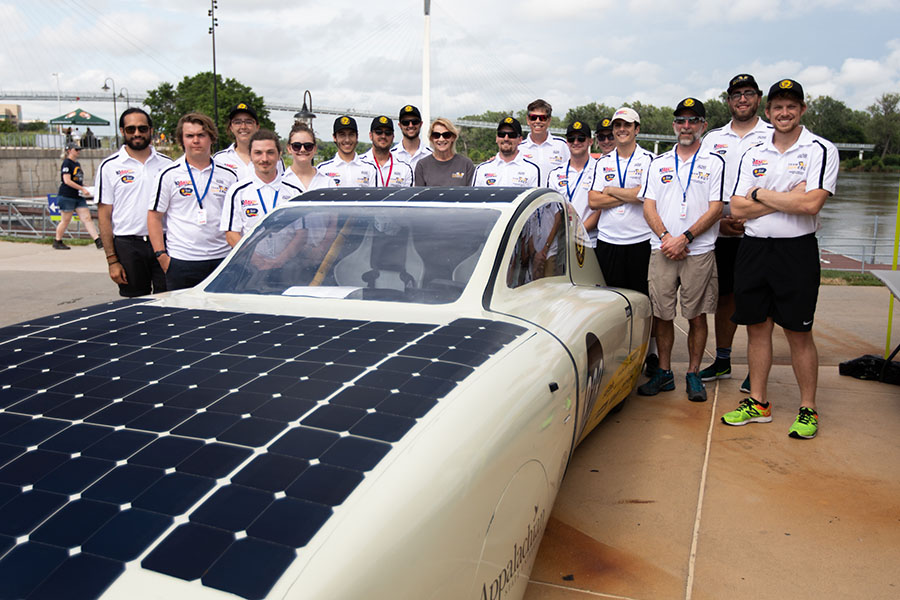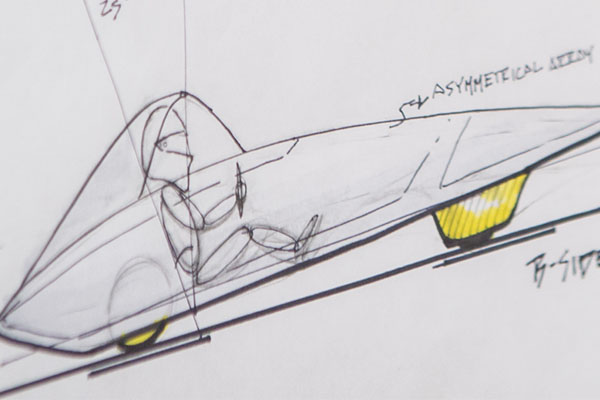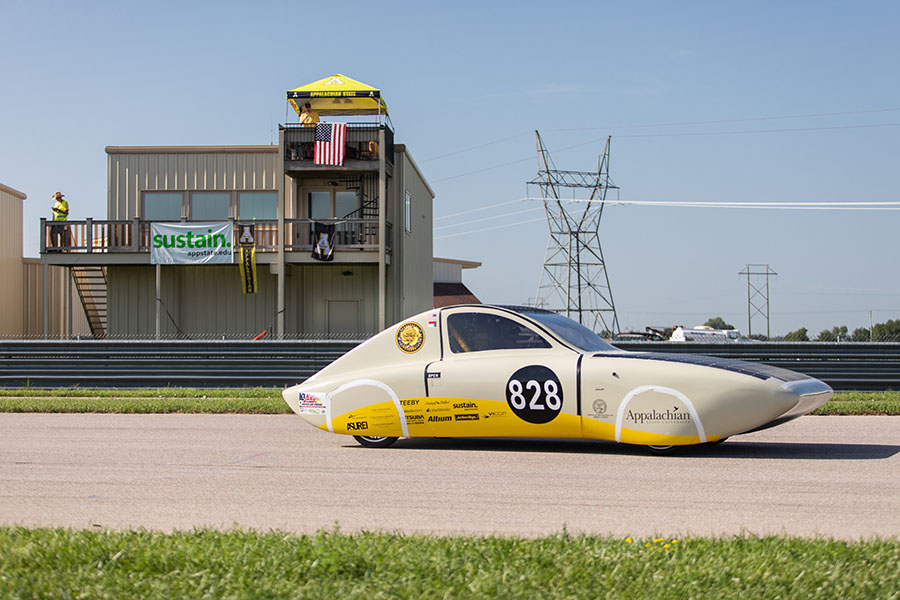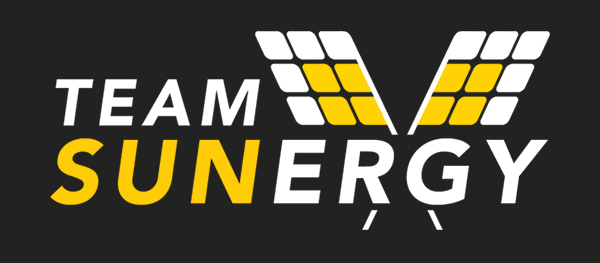HASTINGS, Neb. — Appalachian State University’s Team Sunergy secured a podium spot for the third year running in the Formula Sun Grand Prix (FSGP), an annual competition presented by the Innovators Educational Foundation (IEF), in which teams race solar-powered vehicles for eight hours each day over a three-day period. Team Sunergy placed third in the multi-occupancy vehicle class (Cruiser Class) in the competition, which took place at Motorsport Park Hastings.
Appalachian’s chancellor, Dr. Sheri Everts, at an event celebrating the teams that competed in the FSGP, said, “Our solar vehicle team is an extraordinary example of student leadership changing the future of transportation. I am extremely proud of them.”
This is the third year Team Sunergy has competed in the FSGP. In 2016, the team placed third, and in 2017, the team placed second with their single-occupancy (Challenger Class) vehicle, Apperion. This is the first competition Team Sunergy has entered with its Cruiser Class vehicle, ROSE (an acronym for Running on Solar Energy).
The FSGP is a three-day track race, during which 20 teams compete in two categories, Challenger and Cruiser classes. Cruiser Class vehicles must have the capacity to carry multiple occupants and are more complex than the single-occupancy Challenger Class cars. They are scored based on charging and energy consumption efficiency, as well as number of laps completed. The FSGP is a qualifying competition for the cross-country American Solar Challenge (ASC), a biennial open road endurance race during which each team races its vehicle more than 1,700 miles in nine days.
“We went from design to track in eight months,” said Executive Faculty Director Dan Blakeley ’15 ’18, who founded the team as an undergraduate student and has led the team to success since it began competing in 2016.
The compact schedule presented some challenges for the team. Team Sunergy unveiled ROSE to the public on June 22, revealing a new body design and an overview of many new features — including long-life batteries, tires designed specifically for solar car racing and a sleek body style that rivals the aerodynamics of Tesla vehicles. But when the team arrived at Motorsport Park Hastings on July 4, the car was not fully operational. At the track, team members began the arduous process of wiring the complex battery charging system they had designed.
Scrutineering
Before vehicles can “rayce” (a term coined by the IEF), they must undergo a series of rigorous tests designed to evaluate safety and engineering systems on each vehicle, as well as driver capabilities. This set of nine tests takes place during a three-day “scrutineering” phase of the competition, prior to the start of the track race.
Teams that pass scrutineering challenges are approved to race on the track. Once the race begins, teams who have not qualified can continue scrutineering and can join the race (with penalties) as soon as they pass all scrutineering tests and are cleared by the race officials to get on the track. Teams often assist one another, loaning parts and sharing expertise in order to get as many teams qualified as possible.
In a documentary about Team Sunergy, Gail Lueck, IEF event director and operations director, explained the camaraderie: “Every single one of these teams wants to see every other team get through and pass scrutineering and get out on the track.”
The final day of scrutineering began and ended with Team Sunergy in the garage, continuing to problem-solve the power load and charging systems connecting ROSE’s batteries to its arrays. The complex, computer-driven system, which was designed and built by the team, presented the students and their faculty advisors with conundrum after conundrum. Faculty and students with electrical engineering backgrounds from other teams stopped by to assist in the problem-solving.
Finally, late into the night, with help from a Google electrical engineer and race volunteer, the team worked out its final solution. At 4 a.m. on Rayce Day 1, team members sent word the car was running on its own power for the first time.
Raycing Day 1
At the start of Rayce Day 1, race officials announced the ultimate goal: Complete 143 laps in two consecutive days or 96 laps in a single day to qualify for the ASC. Every registered driver for each team is required to complete a minimum of 24 laps. All teams held the qualifying lap count as their first and foremost goal.
ROSE took its inaugural drive to the track for a photo of all teams, and as the start flag waved and five teams began the raycing, Team Sunergy, along with 15 other teams, hustled to qualify through its final scrutineering challenges. ROSE had battery and charging systems inspections and driver/vehicle dynamics testing yet to go. With prevailing software issues and no drive time, these were not minor hurdles to overcome.
As the day drew on, team after team joined the track. For ROSE, software issues prevailed, but so did Team Sunergy. Other teams with similar charging systems issues bowed out, and as bugs persisted, race officials and volunteers quietly began to count Appalachian out of the competition.
Yet, Team Sunergy refused to give up, doggedly pursuing solutions in the face of dwindling odds. By the end of the day, the team had passed the battery system tests, but it was too late to begin the last qualifying tests. Still to complete: Each of the four drivers had to successfully pass the wet braking test and the driver handling test, which requires driving “slalom style” through a circuit of cones. They had missed the entire first day on the track, yet morale was high. Some of the drivers were also the designers, so they knew what to expect from ROSE. Mechanically, the team felt, ROSE was going to perform well.
Raycing Day 2
Day 2 started early, with a team meeting at 5 a.m. Before the race began at 8 a.m., ROSE’s four drivers, Wyatt Bailey, James Furr, Kali Smith and Lucas Tax, had passed the brake test. As the start flag began the race, ROSE moved into the final test: slalom handling among a cone course.
When Blakeley turned in his inspections checklist to race officials and was given the “all clear” to race, he commented, “You know, 72 hours ago, we had no wiring in our car.” There were, he reported, more than a few surprised stares.
By 2 p.m., ROSE was on the track, with Bailey (sophomore, sustainable technology major) behind the wheel and Smith riding shotgun. As the first driver, he qualified without incident.
“It was very exciting to finally get that green and get out there on the track,” Bailey said. This was Bailey’s first time driving the car, which he described as “a little rattly,” but explained that was to be expected with a prototype vehicle.
Next, Tax took the wheel. Ten laps into his required 24, ROSE began to get hot. How hot, the team didn’t know, because they had not had time to install a thermometer, speedometer or any telemetry systems in the vehicle. ROSE’s systems were wired to shut down at 113 degrees Fahrenheit for safety, however, and shut down ROSE did. The rest of the afternoon was start and stop, with the team logging as many laps as possible while periodically stopping to cool ROSE down.
The day ended with ROSE having made 39 laps and no chance of logging 143 by the end of Day 3. The race was on to complete 96 laps and qualify three drivers in one day.
That night, the team worked late to increase airflow over the battery protection system. With heat indexes in Hastings reaching 105 degrees Fahrenheit, Team Sunergy members were crossing their fingers that their measures would be enough.
Raycing Day 3
The final day of raycing began with a full battery and a pressing question: Would Team Sunergy be able to complete the laps required to qualify for the ASC?
The day progressed smoothly, with the final drivers completing their required laps and getting a feel for the handling, as the car rolled along solidly.
Suddenly, with less than two hours to go, the car died. As ROSE pulled over onto the grass, the car also blew a tire. It took 25 minutes for the support vehicle to tow ROSE into the pit. The team assumed ROSE had overheated again, but realized that a faulty connection had prevented the Maximum Power Point Tracking (MPPT) chargers (electronic DC-to-DC converters that optimize the match between the solar array and the battery bank) were not charging the car.
With precious few minutes left, team members installed a new connector and began charging the car, hoping they could log enough laps to take third place. At this point, all hope of logging the required 96 laps was lost, and Team Sunergy was hoping a third-place win might earn it provisional qualification for the ASC.
“We had almost no mechanical issues,” Blakeley said, “except for one tire change.” This, and the added bonus of discovering the full capacity of ROSE’s battery life, made the team optimistic for its chances in the ASC.
Third-place contender University of Waterloo (Ontario), close behind ROSE, was also suffering charging issues. With only minutes left in the race, both teams struggled to complete one final lap. It was impossible to know who was ahead.
In the end, after penalties had been assessed, Team Sunergy took third place by one lap and earned provisional qualification for the ASC, proving the team’s perseverance had made the difference.
About the Formula Sun Grand Prix
The Formula Sun Grand Prix (FSGP) is an annual track race for solar-powered vehicles that is held on grand prix or road style closed courses. This style of solar car racing is open to teams from around the world and tests the limits of the vehicles in handling curves, braking and acceleration. On years when the American Solar Challenge (ASC) is held, the three-day FSGP event serves as the qualifier race for the ASC competition. Teams must successfully complete the FSGP before beginning the cross-country ASC journey. Learn more at http://americansolarchallenge.org/about/formula-sun-grand-prix.
About the American Solar Challenge
The American Solar Challenge (ASC) is a biennial competition to design, build and drive solar-powered cars across the country in an endurance challenge. This collegiate-level solar car racing event, which is sponsored by nonprofit organization Innovators Educational Foundation (IEF), is designed to promote a greater understanding of solar energy technology, its environmental benefits and its promise for the future; educational excellence in science, engineering and mathematics and the creative integration of technical and scientific expertise across a range of disciplines; and a hands-on opportunity for students and engineers to develop and demonstrate their technical and creative abilities. Learn more at http://americansolarchallenge.org/about/american-solar-challenge.
About App State’s Team Sunergy
Appalachian State University’s internationally recognized Team Sunergy is an interdisciplinary, student-led team with a passion for sustainable transportation — and the ingenuity, innovation and drive to create it. The team began in fall 2013, as a class project to build a solar-powered golf cart, and has evolved into an award-winning program that has achieved podium finishes in every year of competition in both the Formula Sun Grand Prix and American Solar Challenge (ASC), including a first-place finish in the 2021 ASC. Both races set the standards for and test the limits of solar vehicle technology. Team Sunergy’s first vehicle, Apperion, was a modified single-occupant race car. In 2018, the team designed and built its current, two-passenger, Cruiser Class car, ROSE (Racing on Solar Energy), from the ground up. Learn more at https://sunergy.appstate.edu.
About Appalachian State University
As a premier public institution, Appalachian State University prepares students to lead purposeful lives. App State is one of 17 campuses in the University of North Carolina System, with a national reputation for innovative teaching and opening access to a high-quality, cost-effective education. The university enrolls more than 21,000 students, has a low student-to-faculty ratio and offers more than 150 undergraduate and 80 graduate majors at its Boone and Hickory campuses and through App State Online. Learn more at https://www.appstate.edu.
What do you think?
Share your feedback on this story.

